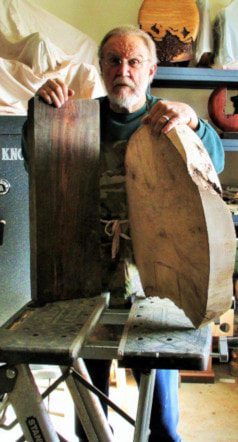|
I am interested in contrast. Our world confronts us with distinct contrasts: black versus white, right versus wrong, absolute truth versus truth by consensus, etc. In an increasingly relativistic society, such contrasts, like its people, lose their identity. With my sculpture, I try to represent this contrast by depicting order versus chaos, space versus negative space, geometric versus organic, etc. While my work appears abstract, it is actually quite representational from a conceptual standpoint. It represents the logical order of things; i.e., the steady decay of all systems over time - what in physics is referred to as entropy, or the "Second Law of Thermodynamics". Wood is elemental, wood is primitive, and an organic material that suits me both artistically and philosophically. From the standpoint of an artistic medium, it provides its own contrast to our increasingly technological society. The Lord created the trees, and from those trees, woods with beautiful colors and intricate grain patterns. I attempt to create pleasant and interesting shapes using those woods. It is my challenge to to make minor additions without taking away from His work . . . essentially “touching up” a previously prepared canvas. It is a partnership in which I am humbled to be the junior partner.
http://www.peersculpt.com |
Available Artwork
Weed Pot #58
Mountain Mahogany wood sculpture by Gary Holt Peer
Measures approximately: 7” x 5” x 2''
Call for Shipping Quote.
Weed Pot #64
Sold out
Madagascar Rosewood wood sculpture by Gary Holt Peer
Measures approximately: 7” x 5” x 2''
Call for Shipping Quote.
Weed Pot #70
Black Walnut wood sculpture by Gary Holt Peer
Measures approximately: 7” x 5” x 2''
Call for Shipping Quote.
Archived Artwork
SOLD Ancient Waters, 2021
Sold out
African Padauk wood sculpture by Gary Holt Peer
17” x 17” x 4”
Call for Shipping Quote.
Birth Pod III, 2021
English Walnut wood sculpture by Gary Holt Peer
19” x 6” x 4”
Call for Shipping Quote.
Conversation, 2019
Macassar Ebony wood sculpture by Gary Holt Peer
27” x 18” x 4”
Call for Shipping Quote.
Destination, 2021
Black Walnut wood sculpture by Gary Holt Peer
19” x 18” x 5”
Call for Shipping Quote.
Erosion, 2021
Honduran Mahogany wood sculpture by Gary Holt Peer
21” x 20” x 4”
Call for Shipping Quote.
Isolation, 2019
Purpleheart wood sculpture by Gary Holt Peer
16” x 18” x 4”
Call for Shipping Quote.
Lignoglyphs, 2021
Zebrawood sculpture by Gary Holt Peer
23” x 20” x 4”
Call for Shipping Quote.
Outgrowth No. 4, 2018
East Indian Rosewood sculpture by Gary Holt Peer
27” x 8” x 5”
Call for Shipping Quote.
Pillar III – Craters, 2020
Oregon Black (Claro) Walnut wood sculpture by Gary Holt Peer
46” x 7” x 5”
Call for Shipping Quote.
Scimitars, 2020
African Padauk wood sculpture by Gary Holt Peer
29” x 8” x 6”
Call for Shipping Quote.


